
© 1989 Angels
Think back to the year 1981, some of us were still pissing ourselves, or not even born. Rick Springfield was singing Jesse's Girl, Blonde was rapping to Rapture, Regan was doing some acting in the White House and Blek Le Rat was painting the streets of Paris. Unknowingly becoming one of the first pioneer stencil artist of the modern street art movement. Often overlooked by more well known media savvy stencil artists, Blek Le Rat was clearly behind many of the styles we see in the streets today. Although much of Blek's early work was in the streets of Paris, It was not long before he was traveling the globe and leaving street pieces at every stop, and he still is today. -Manuel Bello
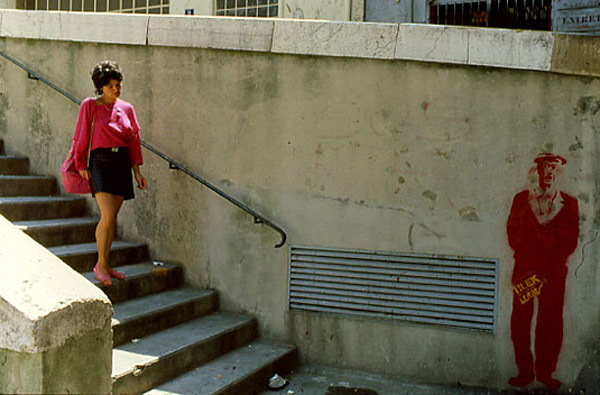
© 1983 Irish Man in Protest
How would you describe Blek Le Rat?
Blek Le Rat is me, I am completely inside myself. (laughs) But seriously, as an artist I have always wanted to reach someone. When I was young I would dream of being a pop star. I came to New York in 1971 and it was during the hippy times. The times of Bob Dylan and the Rolling Stones. After being exposed to that I really wanted to be a pop star but as you can see that did not happen. Instead I became an artist. What can I say, I have a normal life, I do not go out very often. I have a wife and a child. I am focusing on my work a lot. I don't take drugs, no wine, no alcohol. Just a completely regular guy who happens to do art in the streets.
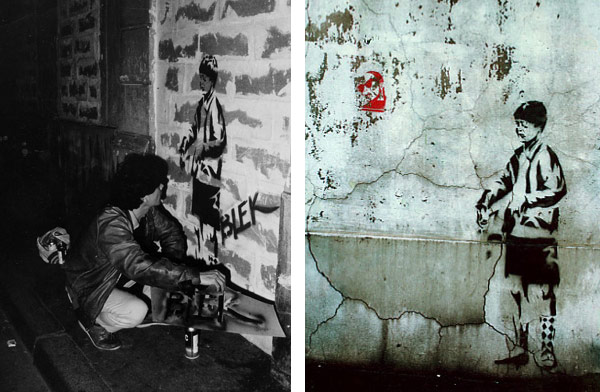
© 1986 self portait
What was it like growing up in Paris in the years following World War II?
Life in those days was not so easy. My life has been not so easy either, not because my parents were bad. My parents were very nice people and always remained together, although my father went through some difficult times. I was always very bad in school. I had a very hard time, some bad memories as a kid. My family life was different than most. My mother was Chinese, my father was born French, my grandmother was Jewish. So I came from a very different mix of cultures. There were many internal conflicts because of the differences. As a child you really do not understand this, it was not until I was 17-18 years old that I began to understand. Before that I was just a child. My father was a solder, he was born in 1914 during World War I. When he was 20 he went into the army, went into the second World War as a solder. As I said, my grandmother was Jewish, but fortunately my father was not raised up in a Jewish manner. He was captured and a German solder came to him and told him to drop his pants and show his parts to see if he was a Jew. Because he denied being a Jew (for obvious reasons) and based on what the German solder saw, he was not killed. Then, when I was 7 he went off to war in Algeria and when he returned he was completely destroyed. His will was broken and he was never the same.
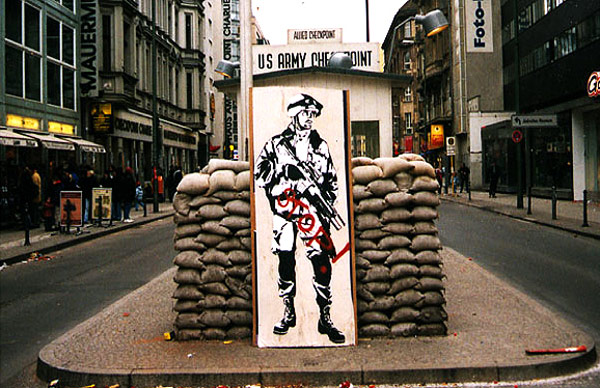
© 2003 No more war, Berlin
What was the interest in art and what lead you to stencil work?
I had a very good friend who was from New York, and he told me that I must go to New York. He said for me it would be such a big discovery. You must remember this was 1971 in France, just 20 years after the war. Life at that time in France was very poor and there was not much going on. I traveled to New York and was really impressed by the graffiti art. Seeing the writing in the subway and a signature with a crown, I said to my friend Larry, "what is that, what does it mean?" Larry told me "I do not know, those people are insane." Keep in mind he too was an artist but he did not understand it either. At the time I was a student of architecture in Paris, it took me ten years to finish school. It also took me ten years to realize that graffiti art was very very important. At that time Basquiat and Keith Haring were not known in France, in the States maybe, but not in France. I had in mind the graffiti from New York and I knew that something was happening in New York by that time. I told my friend J.R. in Paris about the writing in the subway and the streets of New York and he said "That is a fucking great idea." In the beginning we tried to do American pieces but it did not work, we did not have the style. Also, the spray can paint was very expensive in France and we were very cheap with the paint, you know! It was impossible to do something beautiful. I also had this memory from a trip to Italy as a child and the face of Mussolini was stenciled on the walls of Paloma. I remember saying to my father "what is that?" He explained to me that during the war they would do these stencils as a form of propaganda. So with that in mind I told J.R. we are going to make stencils. Mostly because we did not want to stay a long time on the streets because of the police, this was something we could do very quickly. After some time I realized the police did not care. I made hundreds of rats and faces and J.R. made a banana. We would both sign Blek. This was the early part of 1981. We stayed together maybe one year and then J.R.'s wife told him not to go outside anymore and paint this crap, so I was left and I took the name Blek.
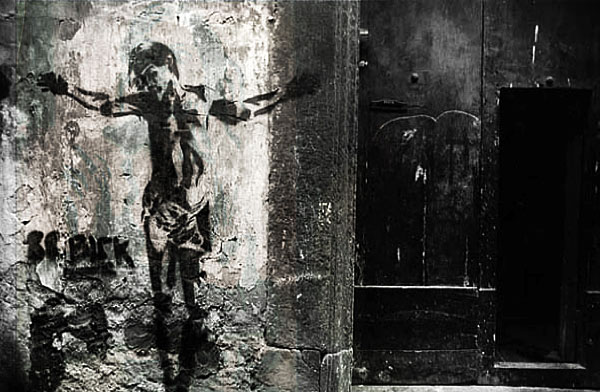
© 1988 Napoli
Can you tell me a little bit about the castle in France where you work?
Oh yes, the castle. I have a small house on the country side in the south of France. There is this castle near my house that I have known about since I was a child. It was abandoned after the war. There was a fire and the woman who lived in it lost her husband there and she left it. She is actually still living but she has another castle in another part of France. Over the course of my life I saw the castle begin to slowly deteriorate. Then in 1990 I started to work on it, to clean it up so I could work in it. As I kid I would go there and party and this sort of thing. It is an interesting place, the sheep roam around in it and there is just something amazing about this place.
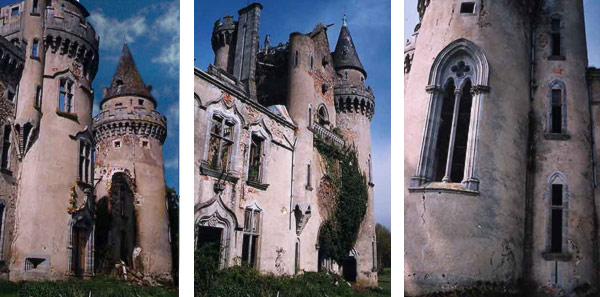
© Le Chateau de Sybille, France
In your last show you did a portrait of yourself as a magician, is magic something that you are interested in?
I do believe in things that are strange or beyond us, things that are beyond our own interpretation of reality. I do believe in ghosts and things like that but I do not dare say this to too many people, people will look at you like you are crazy. I also believe you can look to the future, or you can know your future. I believe that you can have what you wish if you focus your mind on it. You must focus hard and if you want deep in heart something so badly it will happen for you. For me it has taken many years.
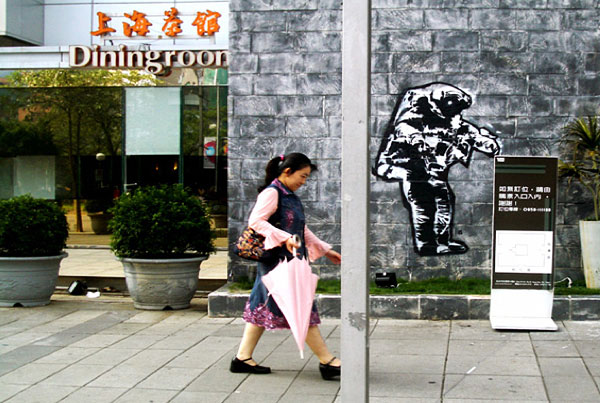
© 2005 Taiwan Paste
The latest street art movement has come to see you as one of the pioneers of stencil art. As one of the first in the current art movement where would you draw inspiration from?
That is a nice thing to hear but there were other guys too. There was an American guy named John Fekner. He used to make stencils in New York in 1978. Not so much pictures but more words and political phrases. He made some really interesting statements. As an artist I do not think that we truly invent anything at this point. For me it is more about focusing on a memory that I may have had, than actually inventing anything. People recreate what they have seen but with their own vision. I do not believe in the painter who says I invent this or that. It does not exist anymore. It is just how you do it that makes it different than others. I can say I have taken inspiration from many places in my life.
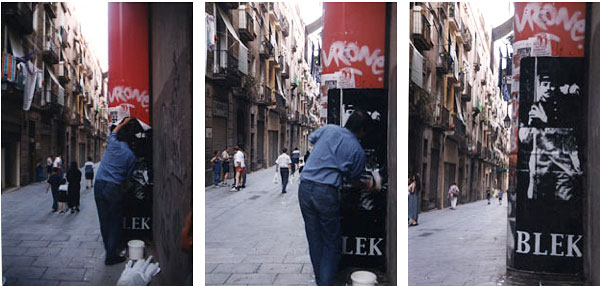
© 2000 Paste up, Paris
How much of your work is politically based?
Some of it is political, not all but some. I have had some problems with that. The David with the machine gun I did to support Israel. This was not well received, especially in Europe because many people do not support Israel. But, I do not support the war between Palestine and Israel. I do not wish for anyone to be killing anyone. I also did one piece based on the homeless people in Paris. The government in France takes care of them. They give them a tent so they can sleep and in some places you will see 30 tents in a row, housing entire families. So I did one stencil called the beggar. I guess that it is more social than political. For me it is about rebellion, the rebellion against (mainstream) art, culture, etc.. I prefer for people to see the image of my work and make their own conclusions about what it means.
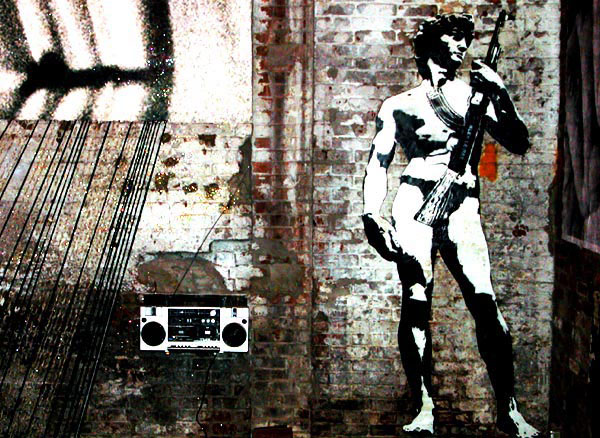
© 2006 David, Spring Street NYC
Do you feel the work you are doing is something that should be preserved?
I do think it is important for art to be preserved. I did not feel the same 10 years ago, I was like fuck this, it is all shit but now I am getting older and have changed my view. I look back and think about the 70's. There is very little left of the graffiti of the 70's. I would like very much to have something from Cornbread or Taki 183, but it is just impossible because the work does not exist. We need to keep something of what has happened for historical reasons. I really believe the graffiti and street art movement is the most important movement in art ever. There is not a city in the world without graffiti now. It has never happened like this with the amount of people involved ever before. Not even in pop art, which was a big movement. Art should be saved for the future generations, which is why I think it is important for the gallery end to support street art, if for nothing else than for history.
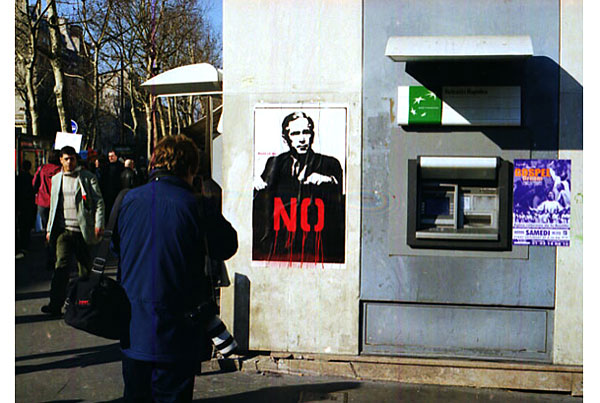
© 2003 No Bush
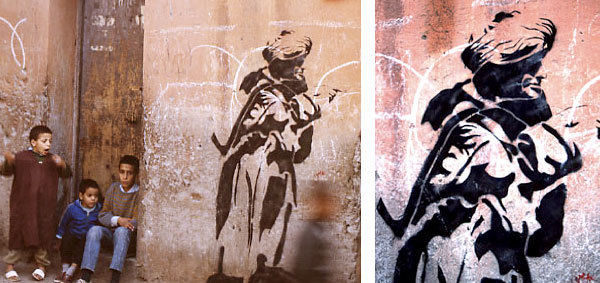
© 1987 Morocco
Can you describe the street scene of the early 80s and your work in those days?
I almost think that during this time in Paris me and my friend J.R. were alone. Or maybe we just did not see the others. It was six or nine months before others began painting, at least this is when we began to notice. There was this one guy who used to go in the subway and repaint the billboards. Also in the early 80s an American guy named Richard Hambleton had come to Paris. This guy was so fucking important to street art. He was the first guy like this to bring his work over from the United States. I remember seeing his work in 82 or 83. By this time I was already making rats, you know, but this guy gave me the idea of making bigger things and figures. His work was large shadow figures and it was very inspiring to me. In the 80s his work was all over New York. After seeing his stuff I began doing larger works and I would often do my self-portrait because I always wanted to be famous. As I said, I always dreamt of being a pop start. It seems funny but this is true.

© 2004 Paris sheep Paste
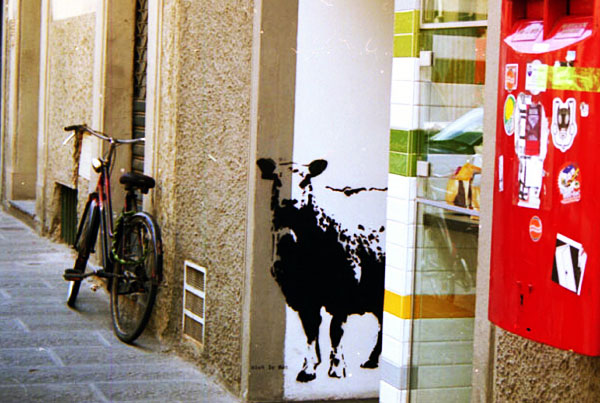
© 2004 Sheep Stencil, London
The famed Banksy has been quoted for saying "Every time I think I've painted something slightly original, I find out that Blek Le Rat has done it as well. Only twenty years earlier..." This being said what are your thoughts on Banksy?
I can tell you now that I have a stock of good ideas for him. Really, I do! I have many good ideas but this time he will have to pay because we all know that he is fucking rich. (laughs) By him saying this it is a good thing. Banksy saying this about me allows me take a little bit back from him. He takes, but we all take from someplace.
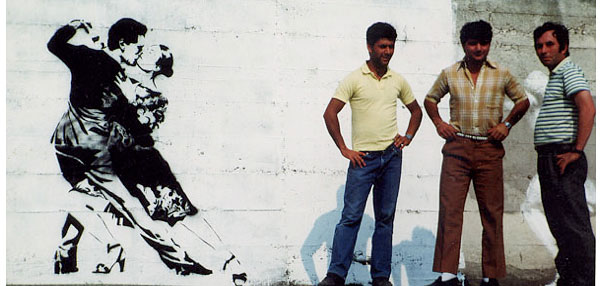
© 1986 Last Tango in Paris

© 2006 Sleeping Bag Paste, 11 Spring Street, NYC
If not graffiti, then what?
I do not know, I guess I would have continued to do architecture. I have done this for 27 years of my life. Very soon I will be an old man. You can smile and pretend that this is not the case but this is true, I know this. You think you will do many things in your life and devote yourself to many different things but I have done only one thing in my life, graffiti. Sometimes I am sad that it still is not more recognized. I have spent many many years at this and still I struggle. In France they say "nobody is a prophet in his own time." It has taken me 27 years to bring my message. I am little known, my work is not in any museums and most of the art establishments still consider graffiti art shit. It is fucking hard, you know...
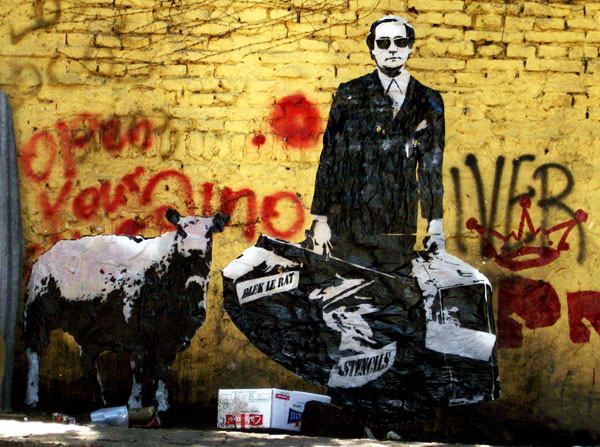
© 2004 Traveler and his Sheep, Buenos Aires
Do you have any famous last words?
This life is fucking important so do not waste yours on bullshit.
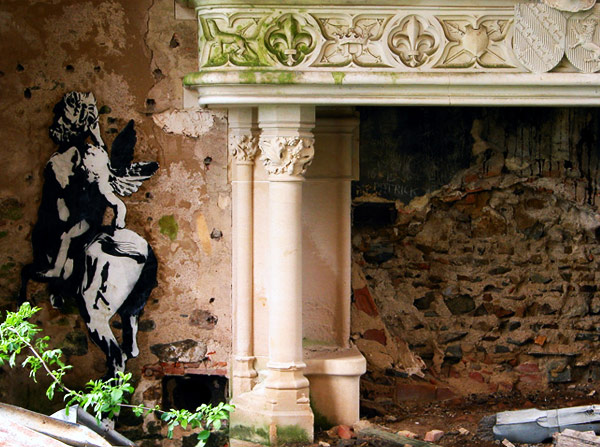
© 2004 Sagitarius, Le Chateau de Sybille, France
Source : FECAL FACE DOT COM
Photos: © Blek Le Rat and Libero De Cunzo
Thanks to: Blek, and Malena Seldin
Interview conducted by NYC correspondent, Manuel Bello.
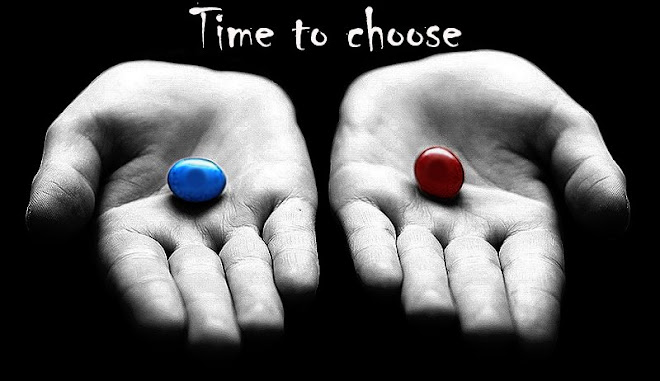
Niciun comentariu:
Trimiteți un comentariu